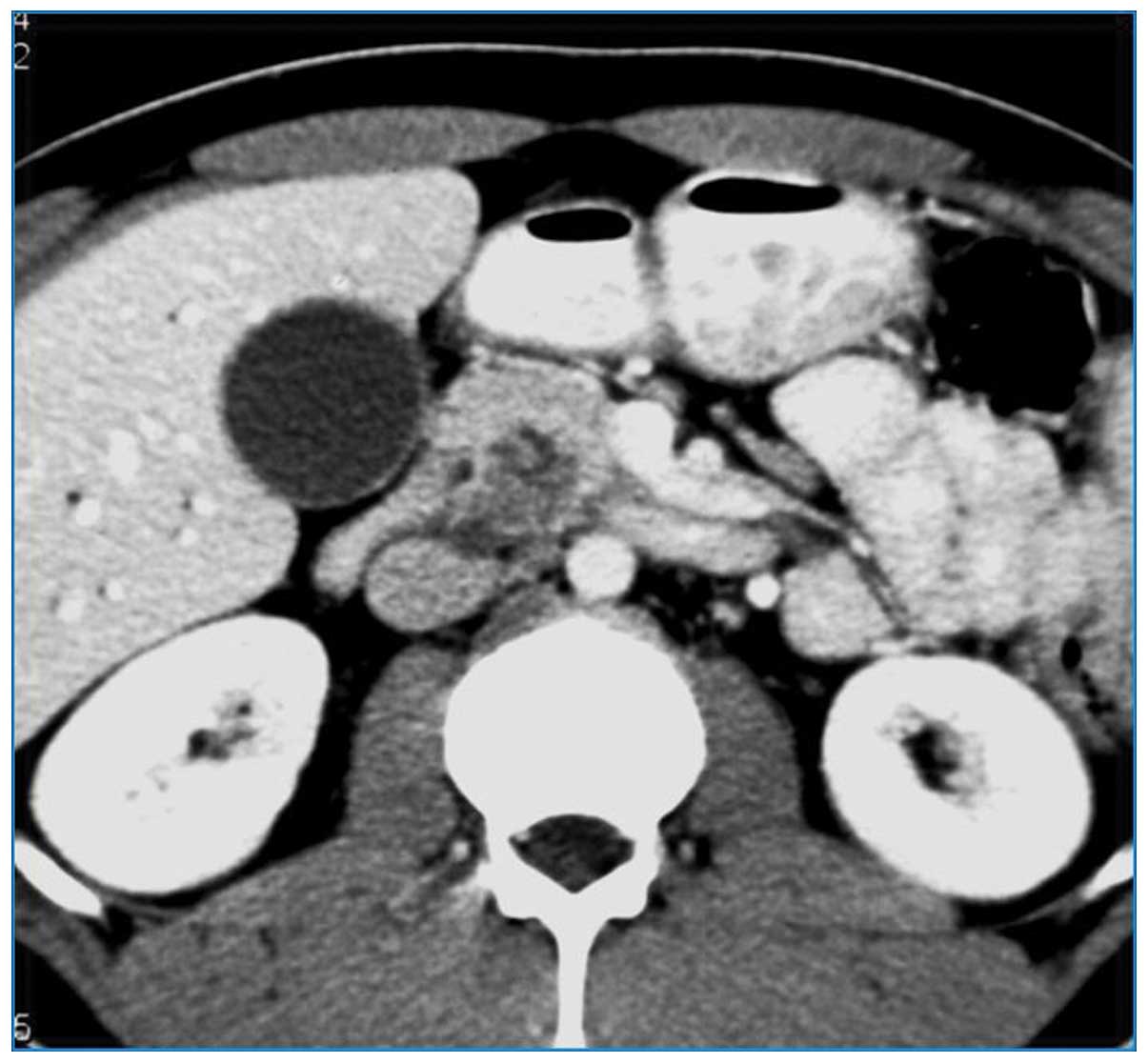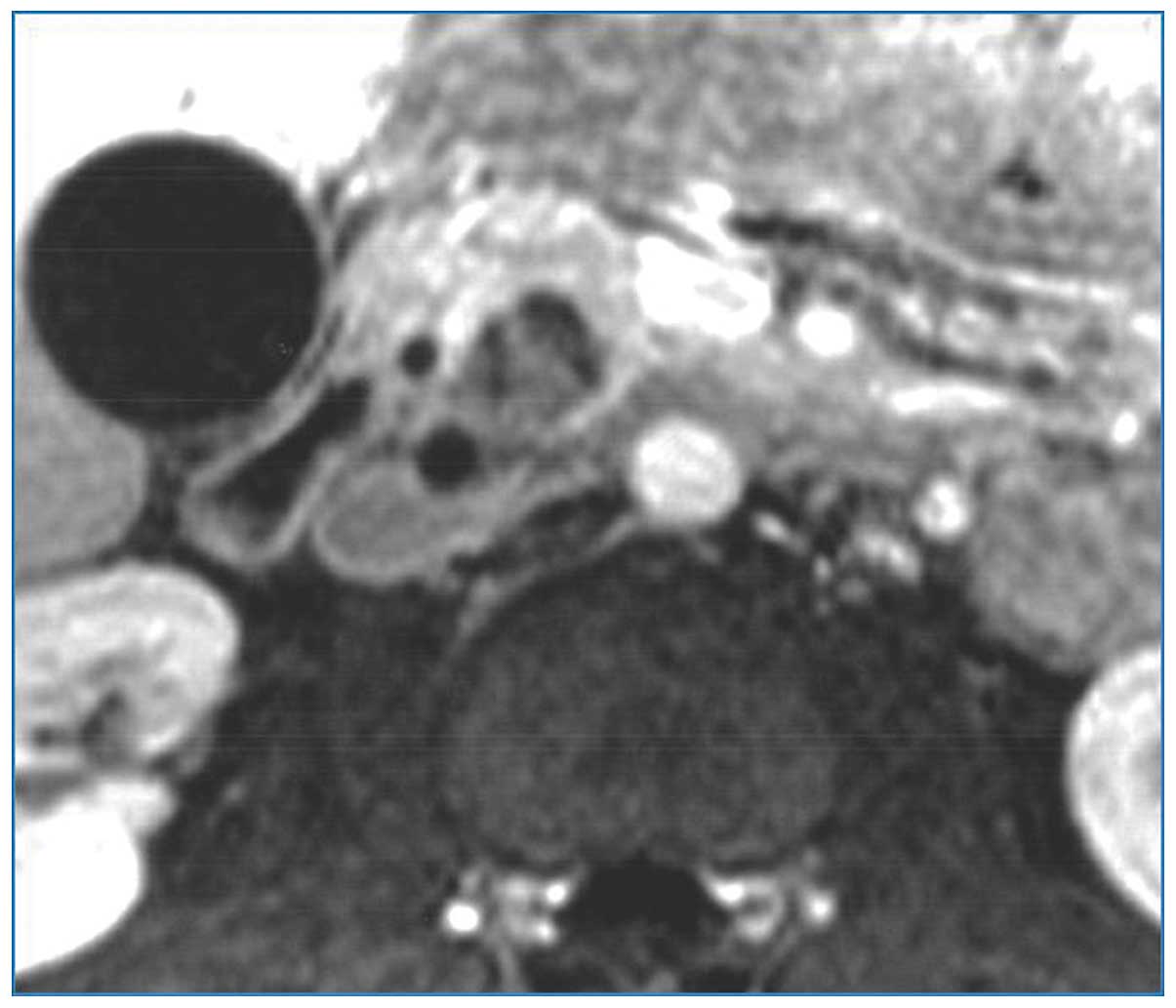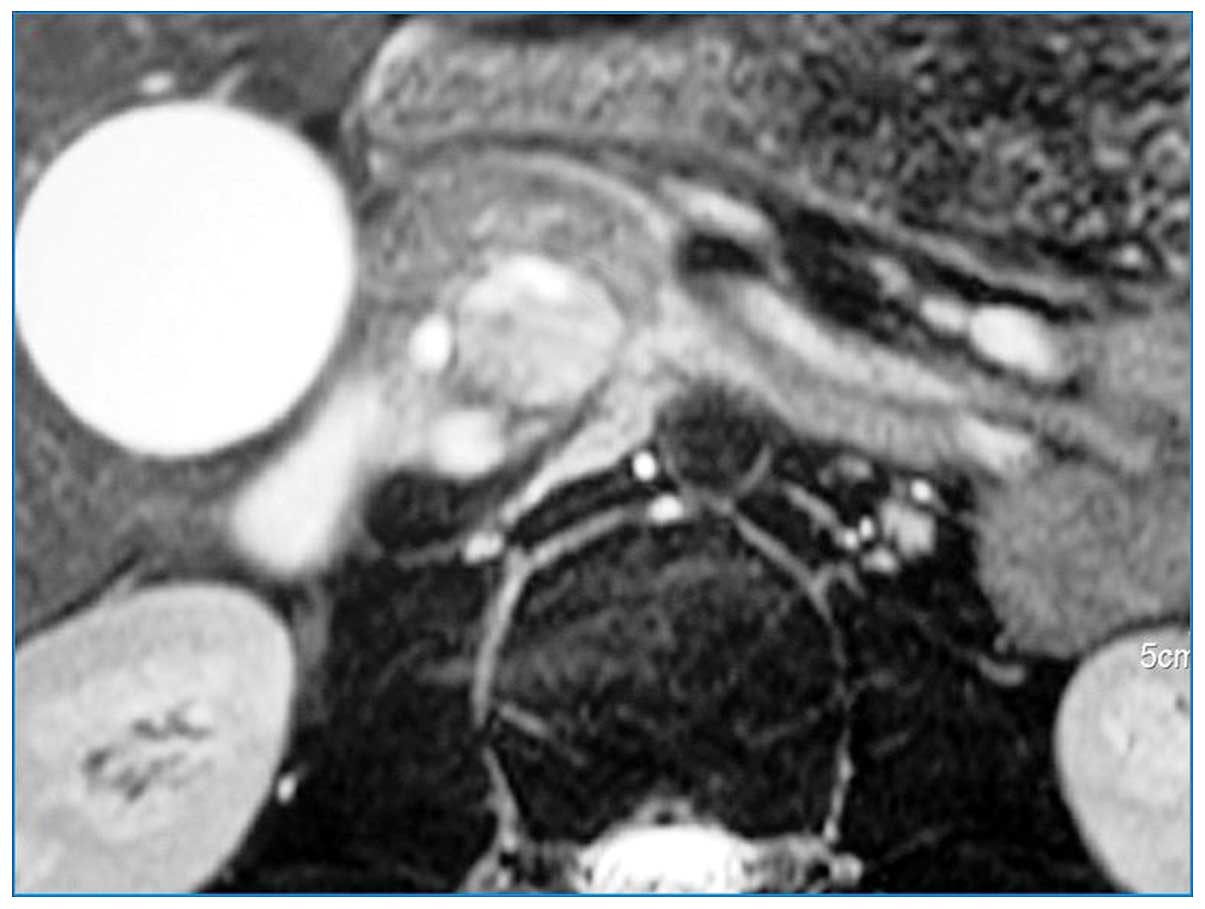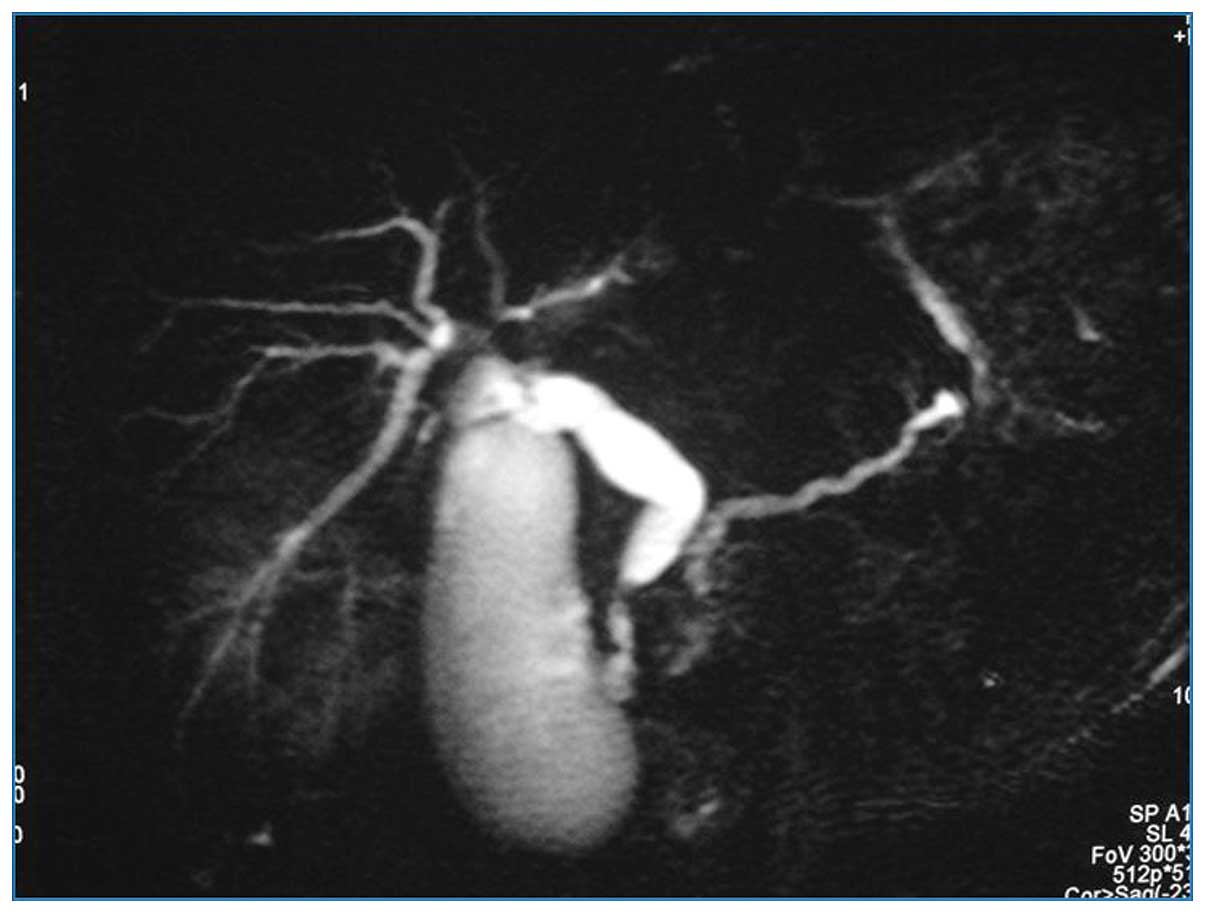Adult pancreatoblastoma: A case report and review of the literature
- Authors:
- Published online on: March 2, 2015 https://doi.org/10.3892/ol.2015.3001
- Pages: 2293-2298
Abstract
Introduction
Pancreatoblastoma (PB) is a rare epithelial neoplasm of the pancreas, typically occurring in the pediatric population. Since the first report of PB in 1957, >200 cases have been described in children, yet only 39 cases have been described in adult patients (1,2).
PB is an aggressive and malignant tumour, exhibiting high rates of local invasion, recurrence and distant metastatic potential. Furthermore, adult patients with PB have a poor prognosis compared with pediatric patients (3). Symptoms are usually vague and radiological features are non-specific. Thus, diagnosis depends largely on the identification of characteristic squamoid corpuscles on histopathological examination, which would appear as whorled nests of flattened cells with a squamous appearance.
Due to its rarity, no guidelines currently exist on the management protocols for PB. Surgery is considered to be the chief treatment strategy, while the role of chemoradiotherapy remains unclear and the significant benefits of the currently employed regimens are limited (3).
The current study presents the case of a 24-year-old patient who was diagnosed with a rare pathology of PB, but succumbed one year later due to disseminated metastatic disease. In addition, a brief review of the relevant literature is discussed. Written informed consent was obtained from the patient's family.
Case report
In March 2013, a 24-year-old Caucasian, male patient was admitted to the Department of Surgery, Konstantopouleio General Hospital (Athens, Greece) with a three-week history of vague upper abdominal discomfort, anorexia and weight loss. A physical examination revealed obstructive jaundice and mild tenderness over the epigastrium.
Laboratory tests identified elevated serum levels of aspartate aminotransferase (247 IU/l; normal range, 10–37 IU/l), alanine aminotransferase (289 IU/l; normal range, 12–78 IU/l), alkaline phosphatase (563 IU/l; normal range, 46–116 IU/l), γ-glutamyl transpeptidase (703 IU/l; normal range, 15–85 IU/l), direct bilirubin (15.9 mg/dl; normal range, <0.3 mg/dl) and total bilirubin (17 mg/dl; normal range, <1 mg/dl). However, carcinoembryonic antigen (CEA), α-fetoprotein (AFP) and cancer antigen (CA)19-9 levels were within the normal ranges.
An abdominal ultrasound demonstrated the presence of an encapsulated and well-defined mass in the head of the pancreas. Contrast-enhanced computed tomography (CT) scans confirmed a heterogeneous, hypodense mass in the pancreatic head, with no dilatation of the main pancreatic duct and no vascular involvement (Fig. 1). Furthermore, contrast-enhanced magnetic resonance imaging indicated the presence of a hypoenhancing, low-intensity mass in the posterior aspect of the pancreatic head abutting the distal section of the common bile duct on T1-weighted images (Fig. 2). A high signal intensity was observed on T2-weighted images (Fig. 3). In addition, magnetic resonance cholangiopancreatography revealed obliteration of the distal common bile duct, with marked proximal dilatation (Fig. 4).
The patient underwent an exploratory laparotomy, during which a palpable mass measuring ~8×7×8 cm was identified in the pancreatic head. No vascular invasion or distant metastases were observed, therefore, a pylorus-preserving pancreaticoduodenectomy was performed. The post-operative course was uneventful and the patient was discharged on the seventh post-operative day.
Histopathological analysis of the resected lesion demonstrated typical features of PB. The tumour was composed of a combination of undifferentiated small cells, and epithelial and stromal components with partial encapsulation. The epithelial component was dominant and demonstrated an acinar architecture, solid sheets and squamoid corpuscles.
Follow-up abdominal CT scans were performed three months post-operatively, and revealed multiple liver and bone metastases. The patient underwent five courses of radiofrequency ablation (15-minute courses of 60 W thermoablation with Elektrotom 106 HiTT needle, Berchtold GmbH and Co. KG, Tuttlingen, Germany) combined with four cycles of systemic chemotherapy, consisting of cisplatin (80 mg/m2 over 24 h) and doxorubicin (60 mg/m2 over 48 h), each course lasted three weeks; however, no response was observed and the patient succumbed 13 months after initial diagnosis due to tumour dissemination.
Discussion
Adult PB is a rare neoplasm of epithelial origin, accounting for <0.5% of exocrine pancreatic tumours (3). PB was initially described by Becker (1) in 1957 as infantile pancreatic carcinoma, however, Horie et al (4) coined the term pancreatoblastoma in 1977. To date, since Palosaari et al (5) reported the first case of PB in a 37-year-old patient in 1986, only 39 cases have been published in the literature (Table I) (3,5–33). A literature search of PubMed was conducted with no language restrictions; studies published between 1986 and 2014 were searched using the key words ‘pancreatoblastoma’, ‘pancreas’, ‘pancreatic tumour’ and ‘pancreatic neoplasm’. Additional studies were identified from the references of the retrieved papers. Cases of PB affecting patients ≥18 years of age were included in the analysis.
PB displays a bimodal age distribution (modal ages, 2.5 and 40 years), while both genders are equally affected (male:female ratio, 1:1) (3,31). The majority of cases are sporadic, however, specific cases are associated with hereditary syndromes, such as Beckwith-Wiedeman and familial adenomatous polyposis syndromes (32).
Symptoms are typically vague and non-specific (3,17,24,30). For example, the majority of adult patients present with abdominal pain or a palpable mass. Additionally, weight loss, anorexia and a change in bowel habits are common symptoms on initial presentation. PBs arising in the pancreatic head may cause biliary obstruction and jaundice, as in the present case. Furthermore, patients may manifest symptoms of endocrine abnormalities (15).
In the present literature review, the pancreatic head, observed in 20/38 patients (53%) was the most common site of tumour origin, followed by the tail, the body and the ampulla of Vater (no tumour site data for two patients). The liver has been found to be the most common site of distant metastasis and 25% of cases are diagnosed with secondary liver disease upon initial staging (19,24,30). However, bone, pulmonary, peritoneal, brain and mediastinal metastases have also been described (19,26).
In paediatric PB patients, elevated AFP and CEA levels are the most common abnormal serological markers, and elevated AFP expression has been reported in ≤68% of cases (12,24,25,32), By contrast, these PB tumour markers are typically within the normal range in adult patients (1,3). Serum AFP levels may be used to monitor clinical response to therapy or recurrence in those patients whose tumors produce it (32).
Forming an accurate pre-operative diagnosis may be difficult when based solely on radiographic features, as these are non-specific and thus, PB cases may be mistaken for more common entities, such as adenocarcinoma or neuroendocrine tumours. The majority of PB tumours are well-defined, large and heterogeneous on cross-sectional imaging, with mixed solid-cystic appearance (3,19,24,26,30). On magnetic resonance, the tumours are most commonly described as heterogeneous with low-intermediate T1 signal intensity and high T2 intensity. Furthermore, PB tumours exhibit enhancement on contrast-enhanced CT scans, with calcifications and internal fibrous septa observed (3,24,30).
The differential diagnosis for PB includes benign and malignant processes of the pancreas, including autoimmune pancreatitis, adenocarcinoma, neuroendocrine tumours, solid pseudopapillary tumours, mucinous cystic neoplasms and serous microcystic adenoma (3,32).
Macroscopically, PB lesions are typically large (≤20 cm in diameter), partially-encapsulated, greyish or tan in colour, with a soft consistency and areas of focal necrosis (3). Microscopic diagnosis may be difficult due to histological heterogeneity. PB tumours often contain multiple cell types, and demonstrate variable combinations of ductal, acinar and neuroendocrine components. This variety of elements is one of the distinctive pathological features of PB, the other being the presence of squamoid corpuscles (i.e., circumscribed, whorled nests of flattened cells with a squamous appearance, separated by dense stromal bands) (3,32).
Ductal adenocarcinoma, acinar cell carcinoma, neuroendocrine neoplasms and solid pseudopapillary tumours all lack the characteristic squamoid corpuscles observed in PB. Therefore, pre-operative cytology is rarely useful, as accurate pre-operative identification of squamoid corpuscles cannot be performed due to sampling errors (3,18,21,33,34). However, PB does not demonstrate the desmoplastic reaction that occurs in adenocarcinoma, allowing differentiation from PB (32).
Immunohistochemistry may facilitate the characterisation of various components of the tumour. For example, acinar cell lines stain positive for trypsin, chymotrypsin and lipase, whereas neuroendocrine cells stain positive for synaptophysin, chromogranin and neuron-specific enolase (3,32). In addition, immunohistochemical analysis of AFP expression may be positive within solid regions of the epithelial component.
Unlike pancreatic ductal adenocarcinoma, PB does not appear to express the K-ras oncogene or p53 tumour suppressor mutations (15,26). However, mutations of the adenomatous polyposis coli/β-catenin pathway have been described, and allelic loss on chromosome 11p (Wnt signaling pathway) is the most common type of genetic alteration that has been identified in PB (12,15,26,35,36). Furthermore, numerous paediatric cases of PB have occurred in patients with Beckwith-Wiedemann syndrome and familial adenomatous polyposis (12,15,19,26,32).
Due to the rarity of PB, an optimal treatment strategy has yet to be standardised, however, in the adult population, surgical resection remains the primary treatment strategy (3,24). The roles of adjuvant chemotherapy and radiotherapy remain under debate due to the small number of patients treated thus far. Typically, chemotherapy with or without radiotherapy has a role in the treatment of recurrent, residual, unresectable and metastatic disease, although with variable outcomes (3,24). However, the development of optimal chemotherapeutic regimens remain under discussion due to the small number of patients reported in the literature (26). In patients with incompletely resected disease, post-operative radiotherapy may be administered as a palliative treatment (3).
PBs exhibit malignant behaviour, with local invasion, recurrence and distant metastasis, and adult PB patients have a poorer prognosis compared with children, exhibiting three-year survival rates of <40% (3,12,19,24). Patients with unresected tumours have a median overall survival time of five months, whereas surgery alone is associated with an overall survival time of 15 months. Furthermore, treatment with chemoradiotherapy following surgery appears to increase the overall survival time to 20.5 months (3). The limited number of reported cases does not allow for valid conclusions to be drawn, however, positive lymph node involvement has been associated with a poorer outcome (overall survival of 12 vs. 36 months with negative node involvement) (3). In addition, there is insufficient data available to evaluate survival with or without vascular or perineural invasion (3).
Although the benefits of neoadjuvant chemotherapy have yet to be studied in randomised trials, it has demonstrated a survival benefit in a small pediatric series (37). Of six pediatric patients treated with neoadjuvant chemotherapy, five exhibited >50% tumour remission, allowing for complete surgical resection in four of the five patients, the fifth patient underwent a laparotomy, however the tumour remained unresectable due to regional extension, and one patient achieved complete tumour regression (37). Therefore, neoadjuvant chemotherapy may have a role in the treatment of adult PB, predominantly in identifying patients with responsive disease, who may be candidates for surgical resection.
In conclusion, PB is an extremely rare neoplasm in adults and the present study showcases its aggressive biological and clinical behaviour. The patient presented with a three-week history of obstructive jaundice and weight loss, and was diagnosed with a pancreatic head mass. Following pancreaticoduodenectomy, the patient developed multiple liver and bone metastases three months later, and despite systemic chemotherapy and radiofrequency ablation, succumbed to tumour dissemination. Pitfalls in the pre-surgical diagnosis of PB, based currently on radiological and cytological findings, and lack of management guidelines, due to the paucity of the tumour, result in a generally unfavourable patient prognosis.
Glossary
Abbreviations
Abbreviations:
|
PB |
pancreatoblastoma |
|
AFP |
α-fetoprotein |
|
CEA |
carcinoembryonic antigen |
References
|
Becker WF: Pancreatoduodenectomy for carcinoma of the pancreas in an infant; report of a case. Ann Surg. 145:864–870; discussion. 870–872. 1957. View Article : Google Scholar : PubMed/NCBI | |
|
Argon A, Celık A, Onız H, Ozok G and Barbet FY: Pancreatoblastoma, a rare childhood tumor: A case report. Turk Patoloji Derg. 11:1–5. 2014. | |
|
Salman B, Brat G, Yoon YS, et al: The diagnosis and surgical treatment of pancreatoblastoma in adults: a case series and review of the literature. J Gastrointest Surg. 17:2153–2161. 2013. View Article : Google Scholar : PubMed/NCBI | |
|
Horie A, Yano Y, Kotoo Y and Miwa A: Morphogenesis of pancreatoblastoma, infantile carcinoma of the pancreas: report of two cases. Cancer. 39:247–254. 1977. View Article : Google Scholar : PubMed/NCBI | |
|
Palosaari D, Clayton F and Seaman J: Pancreatoblastoma in an adult. Arch Pathol Lab Med. 110:650–652. 1986.PubMed/NCBI | |
|
Hoorens A, Gebhard F, Kraft K, Lemoine NR and Klöppel G: Pancreatoblastoma in an adult: its separation from acinar cell carcinoma. Virchows Arch. 424:485–490. 1994. View Article : Google Scholar : PubMed/NCBI | |
|
Dunn JL and Longnecker DS: Pancreatoblastoma in an older adult. Arch Pathol Lab Med. 119:547–551. 1995.PubMed/NCBI | |
|
Klimstra DS, Wenig BM, Adair CF and Heffess CS: Pancreatoblastoma. A clinicopathologic study and review of the literature. Am J Surg Pathol. 19:1371–1389. 1995. View Article : Google Scholar : PubMed/NCBI | |
|
Levey JM and Banner BF: Adult pancreatoblastoma: a case report and review of the literature. Am J Gastroenterol. 91:1841–1844. 1996.PubMed/NCBI | |
|
Robin E, Terris B, Valverde A, Molas G, Belghiti J, Bernades P and Ruszniewski P: Pancreatoblastoma in adults. Gastroenterol Clin Biol. 21:880–883. 1997.(In French). PubMed/NCBI | |
|
Hayasaki N, Miyake N, Takahashi H, Nakamura E, Yamagishi S, Kuno Y, Mori N, Shinoda M, Kimura M, Suzuki T and Tashiro K: A case of pancreatoblastoma in an adult. Nihon Shokakibyo Gakkai Zasshi. 96:558–563. 1999.(In Japanese). PubMed/NCBI | |
|
Montemarano H, Lonergan GJ, Bulas DI and Selby DM: Pancreatoblastoma: imaging findings in 10 patients and review of the literature. Radiology. 214:476–482. 2000. View Article : Google Scholar : PubMed/NCBI | |
|
Mumme T, Büttner R, Peiper C and Schumpelick V: Pancreatoblastoma: a rare malignant neoplasm in early adulthood. Chirurg. 72:806–811. 2001.(In German). View Article : Google Scholar : PubMed/NCBI | |
|
Benoist S, Penna C, Julié C, Malafosse R, Rougier P and Nordlinger B: Prolonged survival after resection of pancreatoblastoma and synchronous liver metastases in an adult. Hepatogastroenterology. 48:1340–1342. 2001.PubMed/NCBI | |
|
Abraham SC, Wu TT, Klimstra DS, Finn LS, Lee JH, Yeo CJ, Cameron JL and Hruban RH: Distinctive molecular genetic alterations in sporadic and familial adenomatous polyposis-associated pancreatoblastomas: frequent alterations in the APC/beta-catenin pathway and chromosome 11p. Am J Pathol. 159:1619–1627. 2001. View Article : Google Scholar : PubMed/NCBI | |
|
Gruppioni F, Casadei R, Fusco F, Calculli L, Marrano D and Gavelli G: Adult pancreatoblastoma. A case report. Radiol Med. 103:119–122. 2002.PubMed/NCBI | |
|
Du E, Katz M, Weidner N, Yoder S, Moossa AR and Shabaik A: Ampullary pancreatoblastoma in an elderly patient: a case report and review of the literature. Arch Pathol Lab Med. 127:1501–1505. 2003.PubMed/NCBI | |
|
Pitman MB and Faquin WC: The fine-needle aspiration biopsy cytology of pancreatoblastoma. Diagn Cytopathol. 31:402–406. 2004. View Article : Google Scholar : PubMed/NCBI | |
|
Rosebrook JL, Glickman JN and Mortele KJ: Pancreatoblastoma in an adult woman: sonography, CT, and dynamic gadolinium-enhanced MRI features. AJR Am J Roentgenol. 184:(Suppl). S78–S81. 2005. View Article : Google Scholar : PubMed/NCBI | |
|
Sheng L, Weixia Z, Longhai Y and Jinming Y: Clinical and biologic analysis of pancreatoblastoma. Pancreas. 30:87–90. 2005.PubMed/NCBI | |
|
Zhu LC, Sidhu GS, Cassai ND and Yang GC: Fine-needle aspiration cytology of pancreatoblastoma in a young woman: report of a case and review of the literature. Diagn Cytopathol. 33:258–262. 2005. View Article : Google Scholar : PubMed/NCBI | |
|
Kuxhaus L, Swayne LC, Chevinsky A and Samli B: Adult metastatic pancreaticoblastoma detected with Tc-99m MDP bone scan. Clin Nucl Med. 30:577–578. 2005. View Article : Google Scholar : PubMed/NCBI | |
|
Rajpal S, Warren RS, Alexander M, et al: Pancreatoblastoma in an adult: case report and review of the literature. J Gastrointest Surg. 10:829–836. 2006. View Article : Google Scholar : PubMed/NCBI | |
|
Cavallini A, Falconi M, Bortesi L, Crippa S, Barugola G and Butturini G: Pancreatoblastoma in adults: a review of the literature. Pancreatology. 9:73–80. 2009. View Article : Google Scholar : PubMed/NCBI | |
|
Comper F, Antonello D, Beghelli S, Gobbo S, Montagna L, Pederzoli P, Chilosi M and Scarpa A: Expression pattern of claudins 5 and 7 distinguishes solid-pseudopapillary from pancreatoblastoma, acinar cell and endocrine tumors of the pancreas. Am J Surg Pathol. 33:768–774. 2009. View Article : Google Scholar : PubMed/NCBI | |
|
Charlton-Ouw KM, Kaiser CL, Tong GX, Allendorf JD and Chabot JA: Revisiting metastatic adult pancreatoblastoma. A case and review of the literature. JOP. 9:733–738. 2008.PubMed/NCBI | |
|
Ohike N, Yamochi T, Shiokawa A, Yoshida T, Yamazaki T, Date Y and Morohoshi T: A peculiar variant of pancreatoblastoma in an adult. Pancreas. 36:320–322. 2008. View Article : Google Scholar : PubMed/NCBI | |
|
Savastano S, d'Amore ES, Zuccarotto D, et al: Pancreatoblastoma in an adult patient. A case report. JOP. 10:192–195. 2009.PubMed/NCBI | |
|
Boix E, Yuste A, Meana A, Alcaraz E, Payá A, Arnold C, Picó A and Lluis F: Corticotrophin-releasing hormone-secreting pancreatoblastoma in an adult patient. Pancreas. 39:938–939. 2010. View Article : Google Scholar : PubMed/NCBI | |
|
Balasundaram C, Luthra M, Chavalitdhamrong D, Chow J, Khan H and Endres PJ: Pancreatoblastoma: A rare tumor still evolving in clinical presentation and histology. JOP. 13:301–303. 2012.PubMed/NCBI | |
|
Gringeri E, Polacco M, D'Amico FE, et al: Liver autotransplantation for the treatment of unresectable hepatic metastasis: an uncommon indication - a case report. Transplant Proc. 44:1930–1933. 2012. View Article : Google Scholar : PubMed/NCBI | |
|
Hammer ST and Owens SR: Pancreatoblastoma: a rare, adult pancreatic tumor with many faces. Arch Pathol Lab Med. 137:1224–1226. 2013. View Article : Google Scholar : PubMed/NCBI | |
|
Redelman M, Cramer HM and Wu HH: Pancreatic fine-needle aspiration cytology in patients <35-years of age: a retrospective review of 174 cases spanning a 17-year period. Diagn Cytopathol. 42:297–301. 2014. View Article : Google Scholar : PubMed/NCBI | |
|
Sigel CS and Klimstra DS: Cytomorphologic and immunophenotypical features of acinar cell neoplasms of the pancreas. Cancer Cytopathol. 121:459–470. 2013. View Article : Google Scholar : PubMed/NCBI | |
|
Jiao Y, Yonescu R, Offerhaus GJ, et al: Whole-exome sequencing of pancreatic neoplasms with acinar differentiation. J Pathol. 232:428–435. 2014. View Article : Google Scholar : PubMed/NCBI | |
|
Wood LD and Klimstra DS: Pathology and genetics of pancreatic neoplasms with acinar differentiation. Semin Diagn Pathol. 31:491–497. 2014. View Article : Google Scholar : PubMed/NCBI | |
|
Défachelles A, Martin De Lasalle E, Boutard P, Nelken B, Schneider P and Patte C: Pancreatoblastoma in childhood: clinical course and therapeutic management of seven patients. Med Pediatr Oncol. 37:47–52. 2001. View Article : Google Scholar : PubMed/NCBI |













